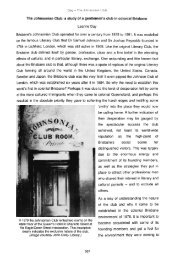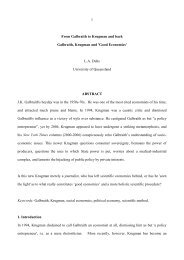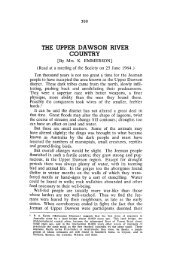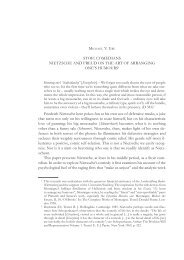Body language: - UQ eSpace - University of Queensland
Body language: - UQ eSpace - University of Queensland
Body language: - UQ eSpace - University of Queensland
Create successful ePaper yourself
Turn your PDF publications into a flip-book with our unique Google optimized e-Paper software.
3<br />
Habits that give an impression <strong>of</strong> nervousness and agitation, detract from a clinician's message and<br />
authority and send non-verbal messages that can be interpreted negatively by patients. 13,25 Negative<br />
body <strong>language</strong> signals may be interpreted as aggressive, condescending, hostile or defiant, and a closed<br />
body <strong>language</strong>; that is arms and/or legs crossed and not looking at the patient, should be avoided. 13<br />
These signals obstruct effective communication because <strong>of</strong> the strong mind-body link. Negative body<br />
<strong>language</strong> makes gathering relevant information almost impossible (when our body closes up, so do our<br />
ears and mind). 13,23<br />
While at first a concerted effort may be needed to correct any bad body <strong>language</strong> habits, eventually<br />
"doing it right" will come automatically. 13,24 Good body <strong>language</strong> that makes a favourable first<br />
impression and earns a patient's respect includes open body <strong>language</strong>, hand movements that are relaxed<br />
and measured in pace, good posture with head held up, a relaxed jaw, firm eye contact (but not staring),<br />
a neutral facial expression, or one that is appropriate for the situation. 8,13,15,17,23,25,26<br />
The way you sit, stand, and use space<br />
Sitting or standing directly opposite someone; that is, squaring up to them, is sensed as<br />
confrontational. 13 To encourage more open and cooperative communication, sit or stand more at right<br />
angles to each other. 13 This sends messages <strong>of</strong> cooperation and gives both the clinician and the patient<br />
more gazing space in which to look away and think. 13<br />
Height communicates dignity and authority and can place others at a disadvantage. 16 Make sure height<br />
does not intimidate people. 13 If a clinician is taller than average, then moving slightly away from<br />
people provides the opportunity for free communication without intimidation. 13<br />
Be aware <strong>of</strong> the use <strong>of</strong> personal space. 8,23 People are generally "touchy" about their personal space, 13<br />
and trespassing into personal space can cause resentment. It irritates people and induces an<br />
uncomfortable setting. 13 Obviously, since the very nature <strong>of</strong> dental intervention requires invasion <strong>of</strong><br />
personal space, attention should also be placed on minimising this during dental procedures. A general<br />
rule is to stand at arms length, and not to overwhelm the patient while reclining in the dental chair. This<br />
applies to most Australians <strong>of</strong> European descent, however, cultural differences in personal space zones<br />
need to be taken into account. 8,13,15 Generally speaking, when compared with Australians <strong>of</strong> European<br />
descent, Australians from Southern Europe, the Middle East and Asia have smaller personal space<br />
zones, while Northern Europeans, and North Americans have slightly larger zones. 13 Australians from<br />
country areas also tend to have larger personal space zones than people from cities. 13 Overall, a good<br />
habit is to take cues about personal space zones from the patient's demeanour. 13<br />
Reading other peoples body <strong>language</strong><br />
While communicating with a patient, it is essential to be alert for positive and negative signals. 4,13,24,27<br />
This provides an opportunity to review what was said or done to trigger a particular reaction and adjust<br />
one's manner to deliver the desired message leading to the best possible result. 4,13 However, care is<br />
needed in interpreting people’s body <strong>language</strong>. 13,27 Crossed arms can say "I feel threatened by what<br />
you're saying and I am closed to hearing it" or it can say "I’m cold". 13 Therefore, it is important to<br />
think about the context in which the body <strong>language</strong> occurs and to observe clusters <strong>of</strong> signals not<br />
solitary signals. 13,15 It is essential for health providers to accurately interpret a patient’s body <strong>language</strong><br />
and facial expressions. Some patients are reluctant to express their feelings verbally, and their body<br />
<strong>language</strong> and facial expressions will <strong>of</strong>ten reflect their level <strong>of</strong> comprehension and apprehension and<br />
accordingly their receptiveness. 8,9,17,25,27<br />
In this context, negative signals include feet pointed away from the clinician (a person's feet will <strong>of</strong>ten<br />
be pointed in the direction they want to go), tapping feet, body orientated away from the clinician,<br />
rapidly nodding head, rubbing or scratching neck or nose, covering nose or mouth, covering or rubbing










![Kanaka Labour in Queensland, [ises-mi] - UQ eSpace](https://img.yumpu.com/21925421/1/163x260/kanaka-labour-in-queensland-ises-mi-uq-espace.jpg?quality=85)





